My Investments Update – November 2024
Here is my latest monthly update about my investments. You can read my October 2024 Investments Update here if you like.
I’ll begin as usual with my Nutmeg Stocks and Shares ISA. This is the largest investment I hold other than my Bestinvest SIPP (personal pension).
As the screenshot below for the year to date shows, my main Nutmeg portfolio is currently valued at £24,799 (rounded up). Last month it stood at £24,625, so that is an increase of £174.
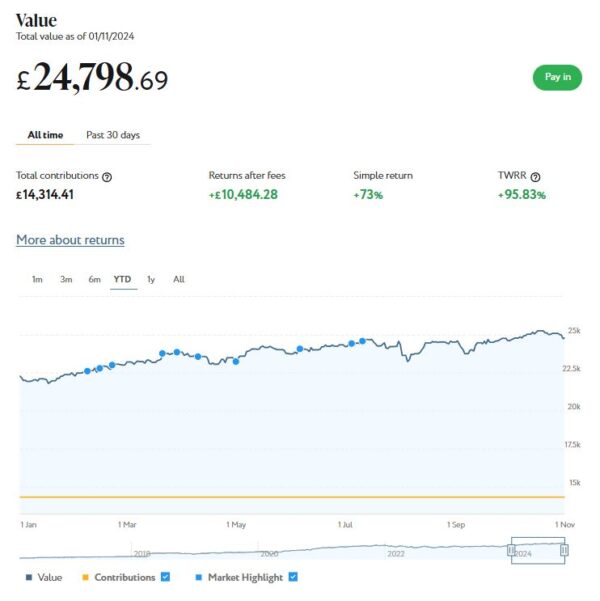
Apart from my main portfolio, I also have a second, smaller pot using Nutmeg’s Smart Alpha option. This is now worth £3,988 (rounded up) compared with £3,954 a month ago, a rise of £34. Here is a screen capture showing performance over the year to date.
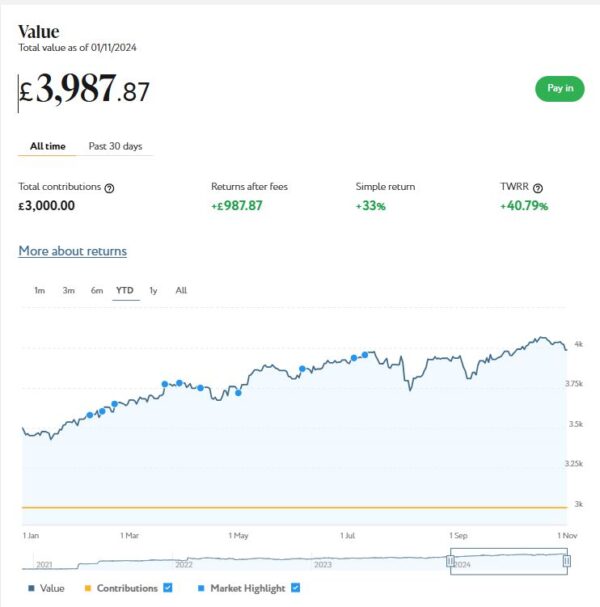
Finally, at the start of December 2023 I invested £500 in one of Nutmeg’s new thematic portfolios (Resource Transformation). In March I also invested a further £200 from referral bonuses. As you can see from the YTD screen capture below, this portfolio is now worth £789 compared with £781 last month, a small rise of £8.
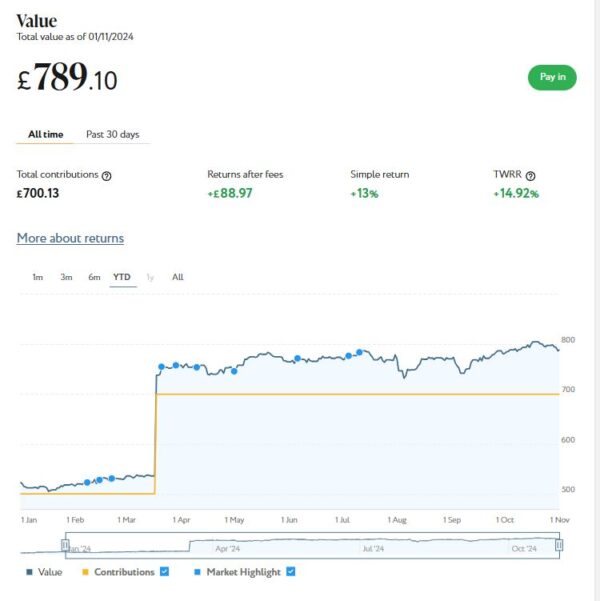
As you can see, October was another decent month for my Nutmeg investments, though the last few days saw a bit of a dip. The overall value has risen by £216 or 0.75% since the start of October. They are also up by £3,261 or 11.62% since the start of the year.
You can read my full Nutmeg review here. If you are looking for a home for your annual ISA allowance, based on my overall experience over the last eight years, they are certainly worth considering. They offer self-invested personal pensions (SIPPs), Lifetime ISAs and Junior ISAs as well.
- Note that I am no longer an affiliate for Nutmeg. That means you won’t find any affiliate links in my review (or anywhere else on PAS). And you will no longer see the no-fees-for-six-months offer I used to promote as an affiliate. However, the better news is that you can still get six months free of any management fees by registering with Nutmeg via my Refer a Friend link. I will receive a gift voucher if you do this, which is duly appreciated
Don’t forget, also, that the current tax year began on 6 April 2024. Despite some predictions to the contrary, you still have a full £20,000 tax-free ISA allowance for 2024/25. As from this year, you can now open any number of ISAs with different providers in the same tax year, as long as you don’t exceed your overall £20,000 allowance. So opening a stocks and shares ISA with Nutmeg won’t prevent you from also opening one with another S&S ISA provider (should you wish to) later in the financial year.
Moving on, I also have investments with the property crowdlending platform Kuflink. They continue to do well, with new projects launching every week. I currently have around £833 invested with them in 7 different projects paying interest rates averaging around 7%. I also have £40 in my Kuflink cash account.
To date I have never lost any money with Kuflink, though some loan terms have been extended once or twice. On the plus side, when this happens additional interest is paid for the period in question.
There is now an initial minimum investment of £1,000 and a minimum investment per project of £500. Kuflink say they are doing this to streamline their operation and minimize costs. I can understand that, though it does mean that the option to test the water with a small first investment has been removed. It also makes it harder for small investors (like myself) to build a well-diversified portfolio on a limited budget.
One possible way around this is to invest using Kuflink’s Auto/IFISA facility. Your money here is automatically invested across a basket of loans over a period from one to five years. Interest rates range from 7% to around 10%, depending on the length of term you choose. Full up-to-date details can be found on the Kuflink website.
You can invest tax-free in a Kuflink Auto IFISA. Or if you have already used your annual ISA allowance elsewhere, you can invest via a taxable Auto account. You can read my full Kuflink review here if you wish.
Note that after this month I will not be including Kuflink in my monthly updates. I am gradually winding down my portfolio with them, as part of the de-risking process for my investments as i get older. As I’ve said above, I have no particular issue with Kuflink, though I do think increasing their minimum investment was unfortunate for the reasons stated above. But I still recommend them if their offering suits your investment strategy and risk appetite.
Moving on, my Assetz Exchange investments continue to generate steady returns. Regular readers will know that this is a P2P property investment platform focusing on lower-risk properties (e.g. sheltered housing). I put an initial £100 into this in mid-February 2021 and another £400 in April. In June 2021 I added another £500, bringing my total investment up to £1,000.
Since I opened my account, my AE portfolio has generated a respectable £215.02 in revenue from rental income. Capital growth has slowed, though, in line with UK property values generally.
At the time of writing, 13 of ‘my’ properties are showing gains, 4 are breaking even, and the remaining 17 are showing losses. My portfolio of 34 properties is currently showing a net decrease in value of £43.61, meaning that overall (rental income minus capital value decrease) I am up by £171.41. That’s still a decent return on my £1,000 and does illustrate the value of P2P property investments for diversifying your portfolio. And it doesn’t hurt that with Assetz Exchange most projects are socially beneficial as well.
The overall fall in capital value of my AE investments is obviously a little disappointing. But it’s important to remember that until/unless I choose to sell the investments in question, it is largely theoretical, based on the latest price at which shares in the property concerned have changed hands. The rental income, on the other hand, is real money (which in my case I’ve reinvested in other AE projects to further diversify my portfolio).
To control risk with all my property crowdfunding investments nowadays, I invest relatively modest amounts in individual projects. This is a particular attraction of AE as far as i am concerned (especially after Kuflink raised their minimum investment per project to £500). You can actually invest from as little as 80p per property if you really want to proceed cautiously.
- As I noted in this recent post, Assetz Exchange is particularly good if you want to compound your returns by reinvesting rental income. This effectively boosts the interest rate you are receiving. Personally, once I have accrued a minimum of £10 in rental payments, I reinvest this money in either a new AE project or one I have already invested in (thus increasing my holding). Over time, even if I don’t invest any more capital, this will ensure my investment with AE grows at an accelerating rate and becomes more diversified as well.
My investment on Assetz Exchange is in the form of an IFISA so there won’t be any tax to pay on profits, dividends or capital gains. I’ve been impressed by my experiences with Assetz Exchange and the returns generated so far, and intend to continue investing with them. You can read my full review of Assetz Exchange here. You can also sign up for an account on Assetz Exchange directly via this link [affiliate]. Bear in mind that, as from this financial year (2024/25), you can open more than one IFISA per year.
In 2022 I set up an account with investment and trading platform eToro, using their popular ‘copy trader’ facility. I chose to invest $500 (then about £412) copying an experienced eToro trader called Aukie2008 (real name Mike Moest).
In January 2023 I added to this with another $500 investment in one of their thematic portfolios, Oil Worldwide. I also invested a small amount I had left over in Tesla shares.
As you can see from the screen captures below, my original investment totalling $1,022.26 is today worth $1,271.89 an overall increase of $249.63 or 24.42%.
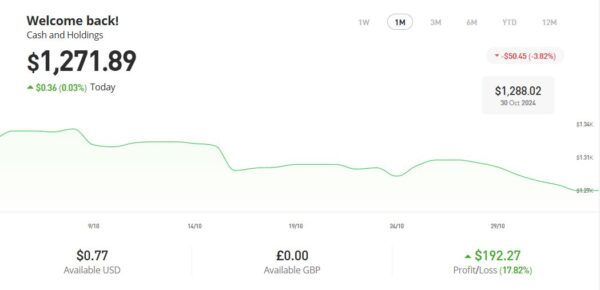
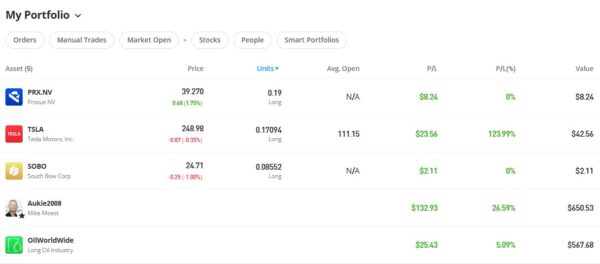
You can read my full review of eToro here. You may also like to check out my more in-depth look at eToro copy trading. I also discussed thematic investing with eToro using Smart Portfolios in this recent post. The latter also reveals why I took the somewhat contrarian step of choosing the oil industry for my first thematic investment with them.
As you can see, my Oil WorldWide investment is showing 5.09% profit. That’s a bit underwhelming, but at least it’s a profit! Obviously my copy trading investment with Aukie2008 has been doing much better.
You might also notice that I have small holdings in Prosus NV, a Dutch internet group, and South Bow, a Canadian energy infrastructure company. To be honest I don’t understand how I acquired these, but I assume they are some sort of bonus I have been awarded. In any event, I am happy to have them in my portfolio!
- eToro also offer the free eToro Money app. This allows you to deposit money to your eToro account without paying any currency conversion fees, saving you up to £5 for every £1,000 you deposit. You can also use the app to withdraw funds from your eToro account instantly to your bank account. I tried this myself and was impressed with how quickly and seamlessly it worked. You can read my blog post about eToro Money here. Note that it can also serve as a cryptocurrency wallet, allowing you to send and receive crypto from any other wallet address in the world.
I had two more articles published in October on the excellent Mouthy Money website. The first is How to Cut Your Energy Bills This Winter. With the coldest winter months fast approaching, energy bills can quickly become a significant financial burden. So in this article I set out some tips to help you reduce your energy costs and keep your home warm without breaking the bank.
Also in October Mouthy Money published my article Always Wanted to be in the Movies? Let TV Studios Use Your Home for Money. As I explained in this, you definitely don’t need to live in a stately home to profit from this opportunity. A huge range of properties is required, so wherever you live there’s a chance it could be the perfect location for an upcoming project.
As I’ve said before, Mouthy Money is a great resource for anyone interested in money-making and money-saving. From the variety of articles published in October, I particularly enjoyed How to Prepare for a Frugal Winter by regular MM contributor Shoestring Jane. Jane writes mainly about money saving and frugal living. You can see all of her articles for Mouthy Money via this web page.
I also published (or republished) several posts on Pounds and Sense in October. Some are no longer relevant, but I have listed the others below.
In Here’s Why I’m Not Doing EDF Energy’s ‘Sunday Saver’ Challenge I set out my reasons for being dubious about this particular money-saving opportunity. This post has actually generated more comments than any before from readers sharing their experiences. If you’re considering doing this challenge (or a similar one from another energy company) I strongly recommend reading what others are saying about it. I must admit that having seen all the comments (those from Harry especially!) I am now more enthusiastic than I was originally, and will be giving it a try in November. Watch this space!
My post on How to Prepare for Winter Blackouts revealed my reasons for believing winter blackouts are increasingly likely in the UK, from government energy policies to the conflicts in Ukraine and the Middle East. I set out a range of tips to ensure that you and your family are well-prepared should the worst happen.
In Will You Get the Warm Home Discount? I discussed this scheme which provides people on low incomes and/or certain means-tested benefits with a discount of £150 on their electricity bill. This is a one-off payment that will be credited to your electricity account by March 2025 (you won’t receive it in cash). The 2024/25 scheme has recently launched, and in this post I revealed who may be eligible.
In my post Should You Take a Lump Sum From Your Pension Now? I looked at the pros and cons of taking a tax-free lump sum from your pension. Retirees can typically withdraw 25% of their pension pot as a tax-free lump sum once they reach the age of 55. At the time I wrote this there was much speculation whether this tax-free allowance would be removed or reduced by Chancellor Rachel Reeves in her budget. That didn’t happen, but you might still find this article informative if taking a lump sum from your pension is on your agenda sometime soon.
My Review of the Simba Orbit Weighted Blanket was a sponsored post. I was sent this product free of charge by my friends at Simba Sleep. In this post I revealed what I thought of it.
And in Twelve Great Christmas Gift Ideas for Older People (That Aren’t Socks) I set out 12 suggestions for presents for older friends and relatives that – based on my experience as an older person myself – should put a smile on their faces! If you’re struggling for ideas for gifts for older friends and relatives, check this out 🙂
Lastly – as referred to earlier – in October we had Labour Chancellor Rachel Reeves’ first budget. This seemed a very long time coming and was the subject of much speculation – and no small amount of dread – beforehand.
My initial reaction was that it wasn’t as bad as it could have been. Several of the possible measures that had been touted didn’t happen. That includes cuts to the £20,000 annual tax-free ISA allowance, the ending of the old person’s bus pass, and the scrapping of the 25% council tax discount for single-person households. The last two in particular would have been very bad news indeed for older people on top of losing (in many cases) their Winter Fuel Payment. Thankfully these things haven’t happened (yet).
Also on the plus side, the additional investment in the NHS is obviously welcome, though in my view this does need to be accompanied by structural changes to boost efficiency and productivity.
On the minus side, although Reeves presented this as a budget for growth, the rise in employers’ National Insurance contributions and other changes brought in by Labour seem more likely to have the opposite effect. They will discourage investment in the UK and potentially lead to job losses as well. Farmers were particularly hard hit by inheritance tax changes. These will potentially generate huge tax bills for family farms and may result in thousands having to sell up. Any farmers among my readers have my sympathy and support.
We will obviously see how things pan out over the coming months and years, but I can’t say I am particularly optimistic over the direction in which this country is heading. In particular – as regular readers will know – I have serious concerns over the effect the government’s reckless pursuit of ‘Net Zero’ will have on our energy security and standard of living. In my view, far more effort should be put into adapting to the effects of climate change, rather than wasting billions on pie-in-the-sky virtue-signalling schemes such as carbon capture machines and giant flywheels. Okay, I’ll get off my soapbox now!
As always, if you have any comments or queries about this update, feel free to leave them below. I am always delighted to hear from PAS readers
Disclaimer: I am not a qualified financial adviser and nothing in this blog post should be construed as personal financial advice. Everyone should do their own ‘due diligence’ before investing and seek professional advice if in any doubt how best to proceed. All investing carries a risk of loss. Note also that posts on PAS may include affiliate links. If you click through and perform a qualifying transaction, I may receive a commission for introducing you. This will not affect the product or service you receive or the terms you are offered, but it does help support me in publishing PAS and paying my bills. Thank you!



